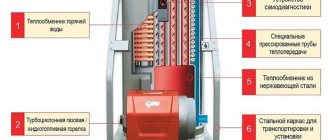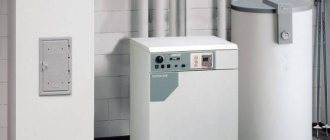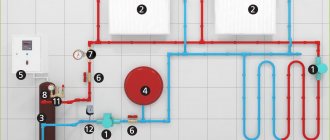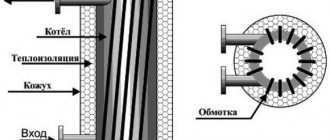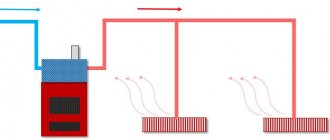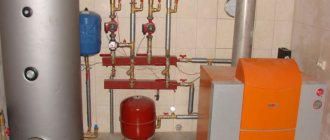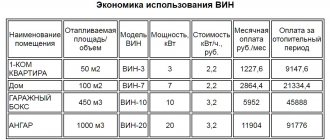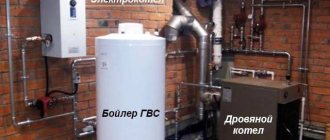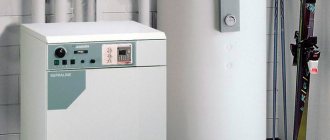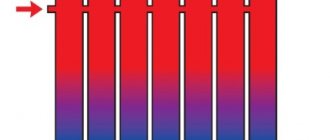Home / Gas boilers
Back
Published: 11/15/2019
Reading time: 5 min
0
16557
Many homeowners are happy to install gas boilers indoors for heating and hot water supply, so as not to depend on the whims of bad weather and pitfalls associated with the operation of municipal heating systems.
In this situation, the correct choice of boiler equipment is of great importance, for which you will need to know how to calculate the power of a gas boiler.
If it exceeds the actual heat loss of the facility, then part of the cost of generating thermal energy will be lost. And units with low heating capacity will not be able to provide households with the required amount of heat.
- 1 What is the power of a gas boiler
- 2 Calculation of the power of a gas boiler depending on the area 2.1 Calculation of a single-circuit heating boiler
- 2.2 How to calculate the power of a double-circuit boiler
- 2.3 Calculation of the power of an indirect heating boiler
What is room heat loss?
Any room has certain heat losses. Heat comes out of walls, windows, floors, doors, ceilings, so the task of a gas boiler is to compensate for the amount of heat coming out and provide a certain temperature in the room. This requires a certain thermal power.
It has been experimentally established that the largest amount of heat escapes through the walls (up to 70%). Up to 30% of thermal energy can escape through the roof and windows, and up to 40% through the ventilation system. Lowest heat loss at doors (up to 6%) and floors (up to 15%)
The following factors influence heat loss at home.
- Location of the house. Each city has its own climatic characteristics. When calculating heat loss, it is necessary to take into account the critical negative temperature characteristic of the region, as well as the average temperature and duration of the heating season (for accurate calculations using the program).
- The location of the walls relative to the cardinal directions. It is known that the wind rose is located in the north side, so the heat loss of a wall located in this area will be the greatest. In winter, cold wind blows with great force from the western, northern and eastern sides, so the heat loss of these walls will be higher.
- The area of the heated room. The amount of heat lost depends on the size of the room, the area of walls, ceilings, windows, doors.
- Thermal engineering of building structures. Any material has its own coefficient of thermal resistance and heat transfer coefficient - the ability to pass a certain amount of heat through itself. To find them out, you need to use tabular data and also apply certain formulas. Information about the composition of walls, ceilings, floors, and their thickness can be found in the technical plan of housing.
- Window and door openings. Size, modification of door and double-glazed windows. The larger the area of window and door openings, the higher the heat loss. It is important to take into account the characteristics of installed doors and double-glazed windows when making calculations.
- Ventilation accounting . Ventilation always exists in the house, regardless of the presence of artificial hood. The room is ventilated through open windows; air movement is created when the entrance doors are closed and opened, people move from room to room, which helps warm air leave the room and circulate it.
Knowing the above parameters, you can not only calculate the heat losses of the house and determine the power of the boiler, but also identify places that need additional insulation.
Formulas for calculating heat loss
These formulas can be used to calculate heat loss not only in a private house, but also in an apartment. Before starting calculations, it is necessary to draw a floor plan, note the location of the walls relative to the cardinal directions, designate windows, doorways, and also calculate the dimensions of each wall, window and doorway.
To determine heat losses, it is necessary to know the structure of the wall, as well as the thickness of the materials used. The calculations take into account masonry and insulation
When calculating heat loss, two formulas are used - using the first, the value of the thermal resistance of enclosing structures is determined, and using the second, heat loss is determined.
To determine thermal resistance, use the expression:
R = B/K
Here:
- R – the value of thermal resistance of enclosing structures, measured in (m2*K)/W.
- K is the thermal conductivity coefficient of the material from which the enclosing structure is made, measured in W/(m*K).
- B is the thickness of the material, recorded in meters.
The thermal conductivity coefficient K is a tabular parameter, thickness B is taken from the technical plan of the house.
The thermal conductivity coefficient is a tabular value, it depends on the density and composition of the material, it may differ from the tabulated one, so it is important to read the technical documentation for the material (+)
The basic formula for calculating heat loss is also used:
Q = L × S × dT/R
In the expression:
- Q – heat loss, measured in W.
- S – area of enclosing structures (walls, floors, ceilings).
- dT – the difference between the desired indoor and outdoor temperatures, measured and recorded in C.
- R is the value of the thermal resistance of the structure, m2•C/W, which is found using the formula above.
- L – coefficient depending on the orientation of the walls relative to the cardinal points.
Having the necessary information at hand, you can manually calculate the heat loss of a particular building.
The best known manufacturers and models: characteristics and prices
BAXI ECO Four 1.14 F
One of the best boilers for heating a private house with an area of 100 m2. The Italian gas wall-mounted single-circuit boiler with a power of 14 kW is known for its high reliability and efficiency - efficiency of 92.5% with a maximum gas consumption of 1.6 cubic meters. m/hour. It also features a copper heat exchanger, virtually silent operation and functional automation with the ability to connect a room thermostat. During the installation practice, no serious deficiencies were identified; according to reviews from the owners, the model has been working without problems for more than 7 years.
Cost: 33,500-35,5000 rub.
Baxi SLIM 1.150i 3E
Floor-standing double-circuit Italian model with a power of 14.9 kW. It is distinguished by the presence of a cast iron heat exchanger, functional and reliable automation, the presence of a circulation pump and a modulated burner. The boiler efficiency is 90.3% with a maximum gas flow of 1.74 m3/hour. The only disadvantages are heavy weight, vulnerability to voltage surges (connection via a stabilizer is recommended) and high price.
Cost: 66,000-69,000 rubles.
Buderus Logamax U072-12K
One of the most affordable reference German models with a capacity of 12 kW (heating and hot water supply). Characterized by good efficiency - efficiency of 92% at a maximum flow rate of 2.1 m3/hour, convenient and functional controls, aesthetic design and compact dimensions. The main advantage over analogues is the price.
However, there are also disadvantages in the form of an insufficiently strong plastic make-up tap and vulnerability to voltage surges. The main advantage over analogues is the price.
Cost: 28,000-31,000 rubles.
Teplodar Cooper Praktik 14
A common budget solid fuel boiler made in Russia with a capacity of 14 kW. It is distinguished by a simple and reliable device, a block of heating elements (6 kW) pre-installed from the factory, which are capable of maintaining an acceptable coolant temperature for a long time, for example at night, after the firewood has burned out. You can also use coal and peat briquettes as fuel.
It has disadvantages typical for the budget price segment: a steel heat exchanger, a small combustion chamber, and is picky about the size of firewood.
Cost: 15-17 thousand rubles.
Combined electric gas boilers: their efficiency, best models and prices
Stropuva S15U
Lithuanian solid fuel boiler with long burning, power 15 kW is more than enough for a house of 100 sq. m. Mine-type model (air supply from above), which, when heating with coal, ensures the burning duration of one bookmark up to 7 days. The boiler efficiency is 85%, which is optimal for a solid fuel model. According to installation practice and owner reviews, no serious malfunctions have been noticed for more than 6 years.
When burning with wood, it has significant disadvantages: high requirements for dry wood and a high level of tar formation on the walls of the firebox. The manufacturer recommends using coal as fuel.
Cost: 99-100 thousand rubles.
Poll: what type of boiler did you choose?
Boiler power calculation
When calculating the boiler power, it is necessary to use a safety factor of 1.2. That is, the power will be equal to:
W = Q × k
Here:
- Q – heat loss of the building.
- k – safety factor.
In our example, we substitute Q = 9237 W and calculate the required boiler power.
W=10489×1.2=12587 W.
Taking into account the safety factor, the required boiler power to heat a house of 120 m2 is approximately 13 kW.
Conclusions and useful video on the topic
Video instruction: how to calculate heat loss at home and boiler power using the Valtec program.
Competent calculation of heat loss and power of a gas boiler using formulas or software methods allows you to determine with high accuracy the necessary equipment parameters, which makes it possible to eliminate unreasonable fuel costs.
Please write comments in the block form below. Tell us how you calculated heat losses before purchasing heating equipment for your own dacha or country house. Ask questions, share information and photographs on the topic.
Gas, solid fuel, liquid fuel or electric
For domestic use, 4 sources of thermal energy (4 types of fuel) are used:
- Gas. Gas boilers are the most widespread, accounting for more than 60% of demand. Using natural gas as fuel is one of the most profitable options. The gas has high heat transfer, when burned it produces a minimal amount of toxic combustion products, and its storage does not require large areas and tanks. At the same time, gas boilers are distinguished by affordable prices (the best models in the middle price segment range from 19-28 thousand rubles), have high efficiency (on average 88-94%), the most developed and functional automation, and work for weeks without human intervention. In general, the gas boiler industry is the most developed and competitive: for the buyer this means the availability of increasingly affordable, high-quality, economical models, as well as a developed service structure (both in Moscow and St. Petersburg, and in the regions).
- Solid fuel (wood, coal, pellets). Solid fuel boilers occupy about 7-15% of the market and are still widely used in places where there is no gas mains or regions with access to solid fuel for a nominal price. The disadvantages of solid fuel boilers are known to everyone - this is the unstable release of thermal energy, the need to procure fuel, organize a place for its storage, constant kindling and cleaning of the boiler unit. To maintain the combustion of wood-burning boilers, human intervention is required on average every 2-4 hours, for coal boilers - 5-10 hours, depending on the type of coal. However, there are also more autonomous and more comfortable to use long-burning models, and there are also pellet boilers with fully automated fuel supply.
- Liquid fuel (diesel, waste oil, fuel oil, kerosene). Diesel boilers and boiler units operating in exhaust gases occupy about 10% of the market and are universal. Liquid fuel boilers are installed exclusively in a separate room under the boiler room, require a fuel storage tank (in the boiler room or outside the house), but at the same time they have high efficiency, are able to work completely autonomously, produce a minimum of toxic emissions when burned, and the cost of fuel is often significantly lower than gas . The most affordable and profitable models are the diesel Navien and Kiturami, which differ from their gas counterparts only in the burner design.
- Electricity . Electric boilers are almost ideal in terms of operating comfort and functionality, however, the cost of electricity is the highest for full heating of a house of 100 square meters. m. can cost from 7 to 10 thousand rubles. per month. It is most rational to use an electric boiler when temporarily living in a house, then the low cost of the boiler and heating system will pay off operating costs for a long time. There are also options for using it in tandem with a buffer tank that accumulates the heat generated by the boiler at a reduced night rate, or using it as a backup boiler unit.
Efficiency and selection criteria for energy-saving electric heating boilers
To summarize, if there is a gas main near the house, we recommend choosing a gas boiler without hesitation. If there is no gas main, you should choose based on personal preferences for the method of maintaining combustion, the availability of fuel in the region, requirements for autonomy, the cost of the boiler and its installation.
